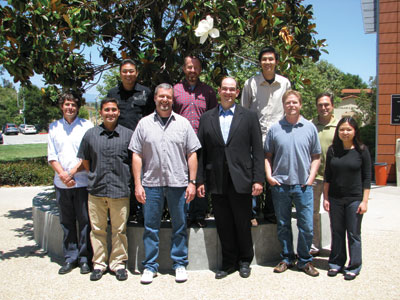Student Systems & Services | Innovators
South Orange County Community College District
Project: Sherpa Project leads: Bob Bramucci, vice chancellor for technology and learning services, and Jim Gaston, associate IT director Technologies used: Developed in-house |
In the Himalayas, Sherpa guides help mountaineers climb higher than they could on their own. That's just what a new software platform--named Sherpa--is designed to do for students in the three-campus South Orange County Community College District (CA).

South Orange County Community College District's Sherpa development team |
Starting in January 2010, an in-house team utilized a service-oriented architecture to develop the first-phase Courses module, which guides students during registration to a substitute class if their first choice is full.
The second-phase Information module provides administrators tools to send "nudges" to students via portal messages, e-mails, SMS messages, and text-to-speech phone calls. The third-phase Services module revamps the student portal with a to-do list, news feed, and calendar pre-populated with enrollments and important dates. This module will soon be available for mobile devices.
"Sherpa isn't one tool, but a student-success architecture with several different software engines that can play together," says Bob Bramucci, vice chancellor for technology and learning services. "Some of these we will design ourselves and others we will buy from vendors. For instance, we are using Blackboard Connect for the messaging aspect."
The Sherpa project, written in Microsoft C#.NET with Microsoft SQL Server as the database, actually grew out of an earlier in-house project to create an academic planning tool called My Academic Plan (MAP), which is fully integrated with the district's registration system.
Although MAP is popular, the development team, including students, thought it would be great if the registration process could be more proactive. "Why shouldn't it be as easy to enroll in classes as it is to buy a book on Amazon?" asks Jim Gaston, associate IT director. "Following the concept of Amazon's recommendation engine has been on our wish list."
Now students are immediately guided toward open sections, and the system can start a dialogue with them to determine preferences such as instructor or time of day. And if a course is full, it will recommend possible alternatives. Soon, Sherpa will be able to use data mining and predictive analytics to show students the courses taken by previous students with similar transcripts and academic goals.
South Orange County Community College District's Jim Gaston and students describe Sherpa. |
Sherpa's combination of a to-do list and the ability for staff members to send reminders to students is appealing, says Juan Avalos, vice president for student services at SOCCCD's Saddleback College. "If students know what to do and when to do it, they will have a much better chance of success," he believes. "I can't make a personal connection with 30,000 students, but this tool offers a way to connect with them before things happen." For instance, if a student hasn't completed his financial-aid documentation, the technology-based nudges can prompt him to take action.
According to Gaston, one key indicator of success is whether or not students create and follow an academic plan. "We can see in profiles which students do not have an academic plan, and we have a tool they can use to create it," he says. "That can become an item on a student's to-do list, with a link to where to do it and an explanation about why it is important."
As with previous in-house software projects at SOCCCD, Sherpa has a large design team of 21 campus constituents and an eight-person development team. In addition to brainstorming sessions, the Sherpa team utilized usability-testing software called Morae to fine-tune the user experience. "If users move easily through the first three steps of a process but get stuck on the fourth step, we can see that and address it," says Bramucci.
Although the Courses recommendation engine has been widely deployed, the other modules are going through extensive pilot testing before wider release. "We have to be careful with the rollout," Gaston notes. "With the pilots, we are working out how to send these nudges without overwhelming students or having them stop paying attention. We don't want to create a spam engine."
"We are trying to get students to take action," explains Avalos, "so we have to find the sweet spot of populating their to-do lists with important things, but not with too much information."
Once all the modules are in use, the next step is getting feedback and assessing the impact. When they receive a nudge, students can rate it on a one- to five-star system and provide comments. "We don't want to create something and then just pat ourselves on the back," Gaston says. "We want to measure that it is making a difference. Everything is logged, so we can see what action the students took."
About the Author
David Raths is a Philadelphia-based freelance writer focused on information technology. He writes regularly for several IT publications, including Healthcare Innovation and Government Technology.

